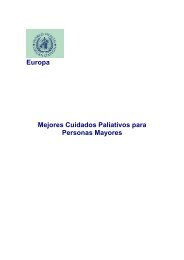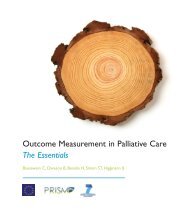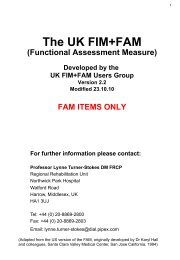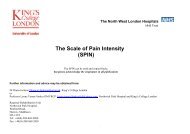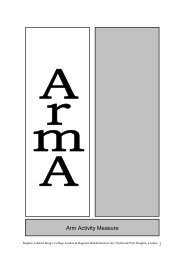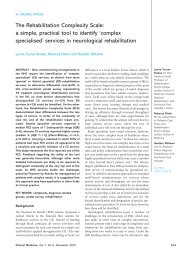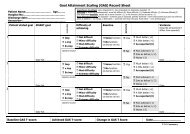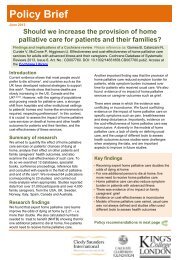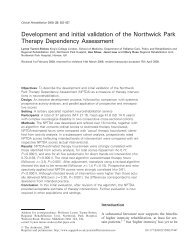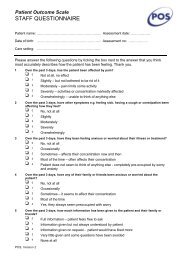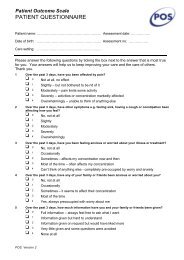2004 - 2007 - Cicely Saunders Institute - King's College London
2004 - 2007 - Cicely Saunders Institute - King's College London
2004 - 2007 - Cicely Saunders Institute - King's College London
Create successful ePaper yourself
Turn your PDF publications into a flip-book with our unique Google optimized e-Paper software.
the POS to identify patient's problems and enables staff<br />
to provide individualised care. It is a flexible tool, the<br />
usage of which can be determined by the needs of local<br />
services. A version completed by the family/caregiver<br />
has also been developed.<br />
The POS showed acceptable validity when used in a<br />
variety of settings, such as home care, hospice inpatient<br />
and day care, and hospital inpatient care, as well as<br />
outpatient and community services. It has also been<br />
shown to be a credible, clinical, research and audit tool,<br />
which is acceptable to both patients and staff and quick<br />
(five minutes) to complete (Hearn and Higginson Quality<br />
in Healthcare 1999;8:219-277). The POS can be used<br />
routinely to guide clinical practice and monitor service<br />
interventions. Moreover, the POS is a valuable audit tool<br />
that can help meet the current statutory requirements on<br />
clinical governance. You can download free copies of<br />
the POS questionnaires from the Questionnaires & tools<br />
section of our website (www.kcl.ac.uk/palliative). A<br />
user's guide to the POS with further details on the<br />
origins of the POS, as well as suggestions for its<br />
implementation in clinical practice and analysis of data<br />
is also available. Table 2.2 shows details of current users<br />
of POS, and external validations which independently<br />
confirm the value of POS assessment and<br />
measurement. A next step with the POS is to test: its<br />
utility in identifying patients who would benefit from<br />
referral to palliative care and potential to assess<br />
complexity and costs using a similar approach to<br />
rehabilitation measures (see 2.3.3); culturally appropriate<br />
formats; and additional modules assessing symptoms or<br />
other aspects in more detail.<br />
Comparison of quality of life scales in<br />
palliative care<br />
Using data collected on 140 patients to evaluate<br />
palliative day care we further explored the factors within<br />
the Palliative Outcome Scale (POS) and other measures<br />
of hope and quality of life. Using these different tools, we<br />
were able to identify a relative factorial structure of all<br />
scales combined. Four components appeared to be<br />
reflected in the different measures – self sufficiency,<br />
positivity, symptoms and spiritual needs. The results<br />
suggest ways in which items within the POS might be<br />
further improved, and suggests that the POS could form<br />
the basis of a measure in the future containing 11 (rather<br />
than 10) items which would explain the variability of<br />
needs within patients and might be useful for identifying<br />
individuals for referral to palliative care 16 .<br />
The German translation of POS<br />
The German version of the POS was translated forward<br />
and backward according to EORTC recommendations<br />
for translation procedures and then validated in palliative<br />
care (hospital support team, hospice, home care) and a<br />
pain clinic. The German POS version was well accepted<br />
by patients and staff, and appears to be valid. The study<br />
identified some areas where the scale would benefit<br />
from expansion to more closely capture staff and patient<br />
concerns 132 .<br />
The APCA African POS<br />
This collaboration between the African Palliative Care<br />
Association (APCA), KCL and National Hospice and<br />
Palliative Care Organisation (NHPCO) (USA), along with<br />
partner agencies in 11 sites across South Africa, has<br />
developed and begun the validation of an African<br />
Palliative Outcome Scale (POS) for use across the<br />
region. This important collaboration will enable future<br />
evaluative efforts to be conducted using a valid outcome<br />
tool, something missing to date. Work is currently<br />
underway to develop an African POS for children.<br />
Funded by the BIG Lottery in the UK, The Encompass<br />
Project (Ensuring Core Outcomes and Measuring<br />
Palliation in Sub-Saharan Africa) unites five sites across<br />
ENCOMPASS<br />
Ensuring Core Outcomes and Measuring<br />
Palliation in Sub-Saharan Africa<br />
South Africa and Uganda: The Hospice Association of<br />
the Western Cape, Philanjalo Hospice in Tugela Ferry,<br />
South Coast Hospice, The N’Doro project at Chris Hani<br />
Baragwanath Hospital in SOWETO, and Hospice Africa<br />
Uganda. The project aims to complete validation of the<br />
African APCA POS and to work with the partners above<br />
to act as “model” audit centres, conducting a full audit<br />
cycle during the second year. This project has achieved<br />
a number of successes: the recruitment and training of a<br />
cadre of African palliative care nurses; the generation of<br />
a large original dataset; and has laid the foundation for<br />
audit in these new services. Harding, Selman and<br />
Higginson are now planning the analysis of the data, so<br />
it can be fed back to services, and the utility of this new<br />
version of POS can be tested.<br />
2.3.2 Common Language Outcome Measures<br />
for Rehabilitation in the UK<br />
In the last triennial report we described the tools we<br />
have developed to measure outcomes from rehabilitation<br />
and provide a common language with which to<br />
compare different populations, programmes and<br />
practices. These include the Northwick Park<br />
Dependency and Care needs assessment (NPDS/<br />
NPCNA) and the UK Functional Assessment Measure<br />
(UK FIM+FAM). A recent survey has demonstrated that<br />
these are now widely taken up and used in clinical<br />
practice in rehab units across the UK 248 .<br />
The NPDA/NPCNA provides a generic measure of care<br />
needs in the community and thus the cost of continuing<br />
care provided by health and social services. Work is<br />
ongoing to develop hospital versions of these scales (the<br />
NPDS-H and NPRNA) which could ultimately be used to<br />
determine the nursing staff required for a rehabilitation<br />
16




